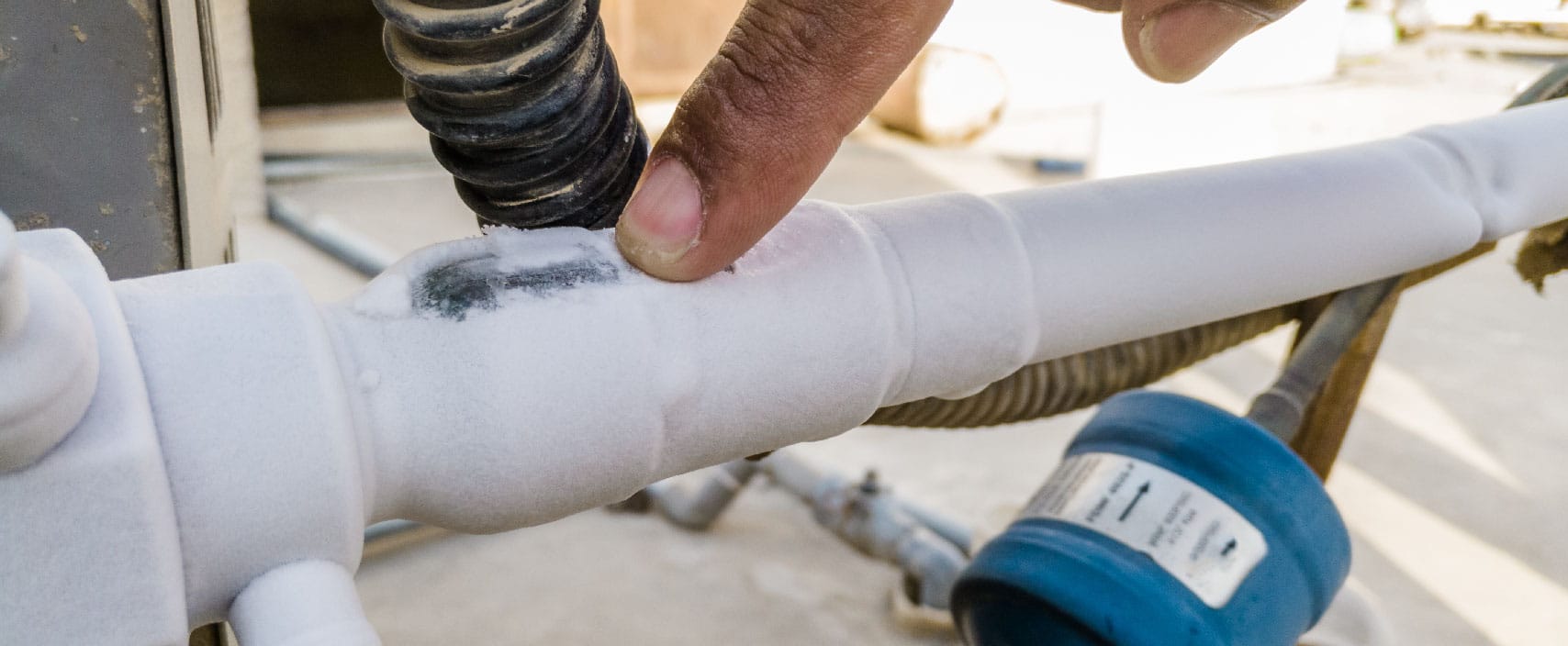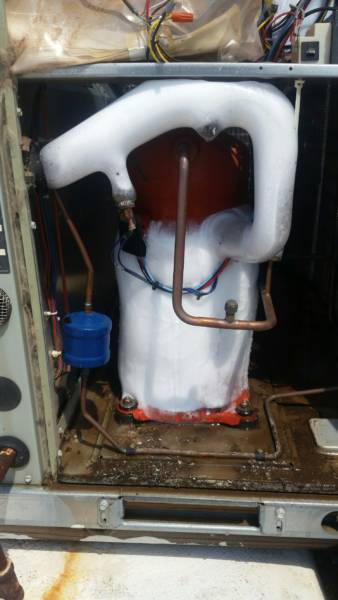Steps to Take When Your AC Pipe Freezes: Crucial Tips
Steps to Take When Your AC Pipe Freezes: Crucial Tips
Blog Article
This great article in the next paragraphs involving What Do I Do If My AC Pipe Is Frozen is rather enlightening. Give it a go and make your own personal final thoughts.

Introduction
Finding that your a/c pipe is frozen can be concerning, especially during warm summertime when you rely on your air conditioner the most. Understanding what to do in such a situation is important to avoid additional damage to your cooling system and ensure your convenience inside.
Recognizing the Causes
Several aspects can contribute to the cold of an AC pipe. Comprehending these reasons can aid you resolve the issue efficiently.
Lack of Airflow
One typical cause of a frozen AC pipe is inadequate airflow. When the air flow over the evaporator coil is restricted, it can cause the coil to drop below freezing temperature level, resulting in ice development on the pipeline.
Low Refrigerant Levels
Not enough refrigerant levels in your air conditioning system can additionally lead to a frozen pipe. Reduced cooling agent levels can trigger the stress in the system to go down, leading to the cold of moisture on the evaporator coil.
Cold Weather Conditions
In chillier climates, freezing temperature levels outside can add to the cold of AC pipes. If your AC unit is not correctly insulated or if there are leaks in the ductwork, cold air can infiltrate the system, creating the pipeline to ice up.
Dirty Air Filters
Unclean or stopped up air filters can limit air flow in your air conditioning system, leading to various concerns, including an icy pipeline. It's vital to change or cleanse your air filterings system frequently to guarantee proper airflow and protect against ice accumulation.
Signs of a Frozen Air Conditioner Pipe
Acknowledging the indicators of a frozen AC pipeline is vital for prompt action.
Lowered Airflow
If you discover a substantial decrease in air flow from your vents, it can show an icy pipe.
Ice Buildup on the Pipe
Visible ice accumulation on the cooling agent line or the evaporator coil is a clear sign of a frozen air conditioning pipe.
Odd Sounds from the Unit
Uncommon audios, such as hissing or bubbling, coming from your air conditioning system can indicate that there's ice present on the pipe.
Immediate Actions to Take
When faced with a frozen air conditioning pipe, it's essential to act swiftly to avoid additional damage to your cooling system.
Turning off the air conditioning
The initial step is to shut off your air conditioner to prevent the system from running and exacerbating the concern.
Looking for Blockages
Evaluate the location around the indoor unit for any blockages that might be blocking airflow, such as furnishings or drapes.
Thawing the Pipe
You can use mild methods like putting towels soaked in cozy water around the frozen pipeline to assist thaw it gradually.
Preventive Measures
Taking preventive measures can help avoid future events of a frozen air conditioning pipe.
When DIY Methods Fail
If your efforts to thaw the pipe or address various other issues are not successful, it's time to employ a professional.
Relevance of Hiring a Professional HVAC Technician
A licensed HVAC professional has the experience and tools needed to identify and fix issues with your a/c system securely and efficiently.
Routine Maintenance Checks
Set up regular maintenance contact a specialist HVAC technician to guarantee that your air conditioner system is running efficiently.
Changing Air Filters
Frequently replace or clean your air filters to avoid air flow limitations and preserve ideal performance.
Protecting Exposed Pipes
If your air conditioning pipelines are subjected to chilly temperatures, think about insulating them to prevent cold throughout winter season.
Seeking Professional Help
If DIY methods fall short to solve the concern or if you're not sure regarding how to continue, it's finest to look for help from a qualified HVAC technician.
Final thought
Handling an icy air conditioning pipeline can be a frustrating experience, yet knowing just how to respond can assist minimize damage and recover comfort to your home. By recognizing the causes, acknowledging the indicators, and taking punctual action, you can properly address the problem and protect against future occurrences.
Frozen AC Line: Why It Happens & What To Do About It
A frozen AC line can be a rather peculiar sight in a place like Phoenix, Arizona where nothing ever freezes. In this post, we’ll discuss what makes an air conditioner line frozen – and what you can do about it.
Dirty Air Filters
Did you know that you should be cleaning or replacing your air filters on a monthly basis? Failing to do this can result in airflow issues that, in turn, cause your evaporator coils and lines to freeze over. You’ll notice a buildup of ice on both components, although the buildup on your pipes will, of course, be more evident unless you open your air condition up to reveal the coils.
What To Do About It
Give your air filter a good cleaning if it’s reusable. If not, replace the filter outright. Next, switch your air conditioner’s fan setting on and leave it there for 2-3 hours. This will draw warm air in, helping to thaw your evaporator coil. You can also check out this article for some tips on cleaning the coils themselves if you’d like to speed the process up. Before you switch the unit back to its normal state, make sure the supply vents are completely unobstructed and free of dust or other debris.
If you keep having this issue even after replacing your filters regularly, contact a local HVAC repair company and have them inspect your evaporator coil, ductwork, and any other components that may be at fault. If you live in the Phoenix, Arizona area, give American Home Water and Air a call.
Low Refrigerant Levels/Leakage
What To Do About It
Contrary to what air conditioner “recharge” companies often tell their clients about refrigerant, it should never need to be simply refilled. You see, refrigerant runs in what experts refer to as a “closed loop.” Refrigerant really shouldn’t be leaving that loop. If it is, you’ve got a leak.
Paying someone to come and pump more refrigerant into your system (aka “recharge” it) isn’t the solution. Doing that will simply kick the can down the road. Besides, refrigerant leaks can be harmful to the environment and people in your home.
Rather, you need to take care of the leak with the help of a technician. Check out this article for some more information about dealing with air conditioners that are leaking refrigerant. Before you contact a technician, switch your thermostat to the off position. Then, switch the fan setting on and let it run for 2-3 hours so the unit can thaw.
Improper Temperature Setting
Improper temperature settings can also cause a drop in your air conditioner’s pressure. What many people don’t realize is that air conditioners are actually designed to run when temperatures have fallen above roughly 60 degrees Fahrenheit. If you run the unit when it’s cold outside, you’ll run into many issues, including frozen components.

Do you like more info about Why Is Ice On My Outside Air Conditione? Try to leave a remark down below. We would be delighted to hear your opinion about this posting. We hope that you visit us again soon. So long as you enjoyed our article please be sure to pass it around. Thanks a bunch for your time. Don't hesitate to come visit our site back soon.
Hire A Pro Report this page